Contacts:
Alan M. MacRobert, Senior Editor
855-638-5388 x2151, [email protected]
J. Kelly Beatty, Senior Contributing Editor
617-416-9991, [email protected]
| Note to Editors/Producers: This release is accompanied by publication-quality graphics and photographs; see details at end. |
Two weeks after seeing a total eclipse of the Moon in the wee hours of October 8th, skywatchers across North America get to witness (weather permitting) a deep partial eclipse of the Sun.
The event begins near the Kamchatka Peninsula in eastern Siberia, then moves eastward and deepens as the Moon moves along its orbit. A partial eclipse will be seen everywhere in North America except for New England and Canada's Maritime provinces. The farther north you are, the deeper the eclipse you'll see; the farther west, the higher the Sun and Moon will be in the sky. East of a line from central Texas north through the Dakotas, the partial eclipse will still be in progress as the Sun sets.
Nowhere will the Sun be completely hidden by the Moon's disk. However, across the northwestern continental U.S. more than half of the Sun's face will be covered, and more than two-thirds will be covered as seen from northern Canada. The eclipse is greatest in Canada's Nunavit Territory near Prince of Wales Island.
The table below gives local times and circumstances for selected cities (note: times before noon are in bold type, and an asterisk (*) means the eclipse is greatest at sunset). Eclipse specialist Fred Espenak provides tabulations for more cities in the United States and in Canada and Mexico.
| Local Times for October 23rd's Partial Solar Eclipse | ||||
| Cities in U.S. | Eclipse begins | Mid-eclipse | Eclipse ends | Max coverage |
| Anchorage | 11:55 | 1:11 | 2:28 | 55% |
| Atlanta | 6:00 | 18:53* | — | 27% |
| Bismarck | 4:10 | 5:27 | 6:36 | 56% |
| Chicago | 4:36 | 5:43 | sunset | 44% |
| Dallas | 4:48 | 5:53 | sunset | 30% |
| Denver | 3:18 | 4:35 | 5:44 | 45% |
| Helena | 2:53 | 4:16 | 5:31 | 56% |
| Juneau | 12:10 | 1:31 | 2:50 | 61% |
| Los Angeles | 2:08 | 3:28 | 4:40 | 34% |
| Miami | 6:27 | 6:45* | — | 5% |
| Milwaukee | 4:33 | 5:41 | sunset | 46% |
| New York | 5:49 | 6:03* | — | 7% |
| Phoenix | 2:21 | 3:38 | 4:45 | 33% |
| San Francisco | 1:52 | 3:15 | 4:32 | 39% |
| Seattle | 1:35 | 3:00 | 4:20 | 54% |
| St. Paul | 4:23 | 5:35 | sunset | 52% |
| Washington | 5:52 | 6:17* | — | 16% |
| Cities in Canada | Eclipse begins | Mid-eclipse | Eclipse ends | Max coverage |
| Calgary | 2:43 | 4:06 | 5:22 | 61% |
| Regina | 3:58 | 5:17 | 6:29 | 61% |
| Toronto | 5:39 | 6:20* | — | 32% |
| Vancouver | 1:32 | 2:57 | 4:16 | 56% |
| Winnipeg | 4:08 | 5:24 | sunset | 60% |
How To View Safely; What You'll See
Unlike a total solar eclipse, which is visible only from a narrow track somewhere across Earth's surface, a partial solar eclipse can be viewed from a wide geographic area. It is a slow-motion event, as the Moon typically takes more than 2 hours to cross the Sun's disk.
Anyone watching the solar eclipse should do so very carefully. "Looking directly at the Sun is harmful to your eyes at any time, partial eclipse or no," explains Alan MacRobert of Sky & Telescope magazine. "The only reason a partial eclipse is dangerous is that it prompts people to gaze at the Sun, something they wouldn't normally do. The result can be temporary or permanent blurred vision or blind spots at the center of your view."
Fortunately, there are many easy ways to watch the show safely. You can look at the Sun directly through glasses equipped with special solar filters, or through a dark #13 or #14 rectangular arc-welder's glass. (Sunglasses, no matter how dark, are not safe for solar viewing.) Another easy method is to create a pinhole projector, made by poking a small hole in a card, facing it toward the Sun, and holding a second card about 3 feet behind it in its shadow. Or you can point binoculars toward the Sun and project the bright disk onto a white card a couple of feet behind the eyepiece.
Sky & Telescope provides more information about safely viewing a partial solar eclipse here.
A solar eclipse can only happen at the time of new Moon, and in particular when the Moon passes directly between the Earth and Sun. This alignment occurs only occasionally, rather than at every new Moon, because the lunar orbit is tipped about 5° to Earth's orbital plane and so the Moon's shadow usually misses Earth entirely.
"Last November, adventurous amateur astronomers had to travel to Africa to view a total solar eclipse," notes Kelly Beatty of Sky & Telescope. "There won't be a total one this year, so everyone in a position to see the partial event on October 23rd should enjoy it if they can."
Click here to read about other solar and lunar eclipses that occurred during 2014.
Sky & Telescope is making the following photo and illustrations available to the news media. Permission is granted for one-time, nonexclusive use in print and broadcast media, as long as appropriate credits (as noted in each caption) are included. Web publication must include a link to SkyandTelescope.com.
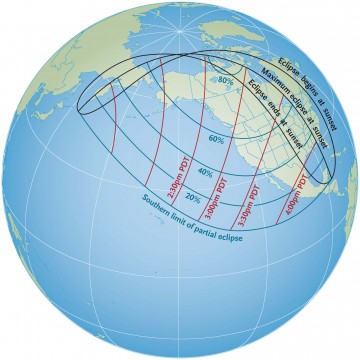
Credit: Sky & Telescope / Leah Tiscione
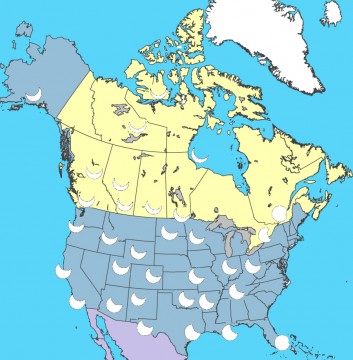
Credit: Jay Anderson
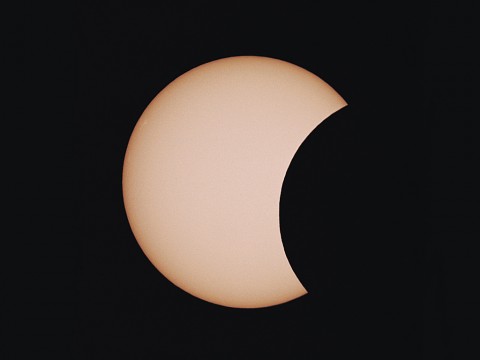
Credit: Richard Tresch Fienberg
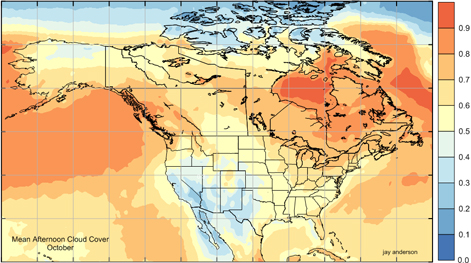
Credit: Jay Anderson; source: NOAA/Patmos-X
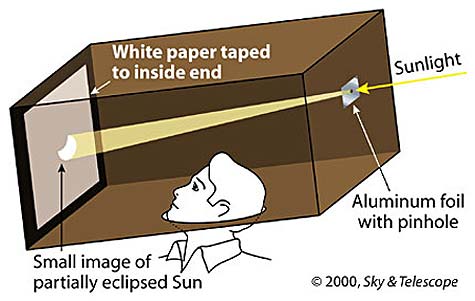
Credit: Sky & Telescope
 0
0
Comments
You must be logged in to post a comment.